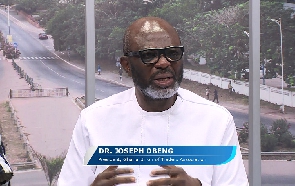- Home - News
- TWI News | TV
- Polls
- Year In Review
- News Archive
- Crime & Punishment
- Politics
- Regional
- Editorial
- Health
- Ghanaians Abroad
- Tabloid
- Africa
- Religion
- Election 2020
- Coronavirus
- News Videos | TV
- Photo Archives
- News Headlines
- Press Release
General News of Monday, 16 June 2014
Source: BFT
SSNIT pays questionable Ghc2.4million to Vanef
The Social Security and National Insurance Trust (SSNIT) paid over GH¢2.4million on behalf Intercity STC (STC) Company Limited to the former owners of STC, Vanef Consortium, to settle a dispute, when in fact a Vanef owed STC over Ghc2.8million, B&FT investigations have revealed.
The majority shareholder of the ailing transport company made the payment to Vanef Consortium, represented by Mr James Owusu Bonsu, the Managing Director, in July and August 2011.
However, an analysis of the financial statements of STC revealed that Vanef was intended to STC to the tune of Ghc2,832,204 at the time of payment, with the amount remaining outstanding to date.
Vanef's liability to STC has been in the transport company's books since 2003.
That meant that STC was rather expecting to receive on amount of Ghc2,832,204 from Vanef Consortium.
However, on July 7, 2011 SSNIT paid Mr Owusu Bonsu, Managing Director of Vanef Consortium Limited (VCL), an amount of Ghc2,325,006 without the knowledge apparently of STC.
Another payment of Ghc97,247.11 was made to Mr. Owusu Bonsu on August 24, 2011.
STC in a letter written on July 11, 2013 and signed by its former acting Managing Director, Mr. Charles Thompson, asked for clarifications on these two payments and three others “made on our behalf without advice to us.”
Asked why Vanef was paid about Ghc2.4million in 2011, Mr. Peter Hayibor, the General Manager/General Counsel of SSNIT, said Vanef sued STC and its partners in court, seeking various reliefs.
Asked whether one of Vanef's claims was that it had lost revenue as a result of losing the management of STC, Mr. Hayibor said: “It was one of the claims. It was a long list.”
He added: “It was at the pre-trial stage that all the parties, including Vanef's lawyers, SSNIT, and other parties met, and it was settled (how much to pay Vanef). It was settled at the pre-trial stage.”
How much did the parties decide to settle for? B&FT asked. “I don't have the figures, but there are documents we can refer to. But the payments here (Ghc2.4million contained in STC's letter written on July 11,2013) reflect what was finally paid to Vanef,” he answered.
Asked whether SSNIT, as majority owner of STC, has reviewed the latter's financials, he said: “Normally, that should happen if they are holding an Annual General Meeting (AGM). We are shareholders, and that is the angle at which we exercise our authority.
“If they furnish us with their financial statement, normally it will go to equities (a department in SSNIT).They will analyse it, attend the AGM and raise all the issues. Then the management will be informed.”
Though STC held an AGM in 2011 and presented their financial statement, SSNIT claims it dId not know about any indebtedness of Vanef to STC. It also went ahead to settle the lawsuit brought against STC by Vanef in full without recourse to STC.
If around 2011 STC held an AGM, it would have reflected that Vanef owed STC. Wouldn't it, B&FT asked? “Unless anybody draws attention to it, it wouldn't be known,” Mr. Hayibor, who was part of the negotiations with Vanef, said, before adding: “This is the first time I have heard this. This one is news to me because we will not be privy to the internal things happening there (STC). If Vanef owed STC and Vanef was going to be paid, that could have been used to offset what Vanef owed STC.”
Aside the issue of the legitimacy of the payment, B&FT asked Mr. Hayibor why SSNIT did not pay Vanef as an entity, but rather paid the amount directly into the personal account of the MD, Mr. Bonsu?
Mr. Hayibor answered: “But he was the Managing Director of Vanef and all kinds of things. |ln| most of these things what we do is that we don’t pay cheques. He provided his personal account for the transfer; that is why this would have happened. So with Vanef, he might have provided his personal account.”
Is that a standard practice? “No, it depends on what he provided at the time. I don't know what shareholding they have at Vanef as a private company. But as far as we are concerned, he filed the process; he was representing the company as the MD.” The troubles of STC began with its acquisition by Vanef when the government put the company on diverstiture.
Vanef, unable to pay fully for the stated value of the company by the Divestiture Implementation Committee (DIC), approached SG-SSB bank for a loan to complete the acquisition. SSNIT acted as a guarantor for the loan. Subsequently, the name of the entity was changed from STC to Vanef STC Limited.
Though Vanef operated the entire fleet of the transport company, it failed to pay the loan. This left SG-SSB with no choice but to recoup the loan from SSNIT, the guarantor.
SSNIT in turn, activating a clause in an initial agreement with Vanef, re-possessed the company and re-named it Intercity STC Coaches Limited in 2001. SSNIT currently holds 80 percent stake in the transport company, with the rest held by government.
Government, through the Transport Ministry, has indicated that it wants to fully take over STC and is preparing to acquire the 80 percent stake of SSNIT, after which it will seek a strategic partner to help it revamp the company.










